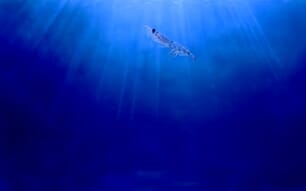Identity
Pangasius hypophthalmus Sauvage, 1878 [Pangasiidae]
FAO Names: En - Striped catfish, Fr - Silure requin, Es - Tiburón pangasio

Biological features
Body long, latterly flattened with no scales. Head relatively small. Mouth broad with small sharp teeth on jaw, vornerine and palatal bones. Eyes relatively large. Two pairs of barbels, upper shorter than the lower. Fins dark grey or black. Six branched dorsal-fin rays. Gill rakers normally developed. Young fish have black stripe along lateral line and another long black stripe below lateral line; large adults uniformly grey but sometimes with greenish tint and sides silvery. Dark stripe on middle of anal fin; dark stripe in each caudal lobe; small gill rakers regularly interspersed with larger ones.
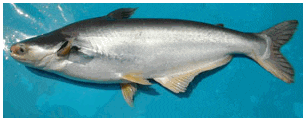

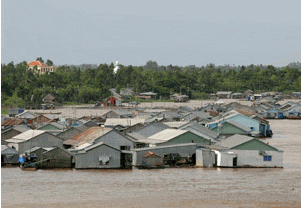
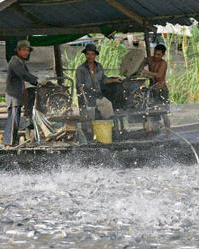
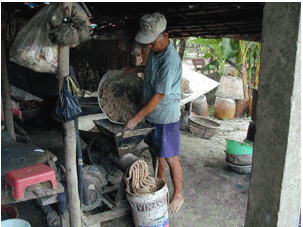
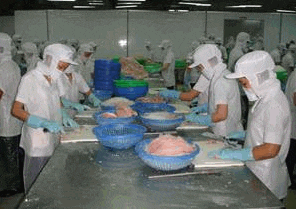
Profile
Historical background
Pangasius hypophthalmus is one of the major fish species in the Mekong River fishery, one of the largest and most important inland fisheries in the world. The traditional development of capture-based aquaculture for this species, particularly in Viet Nam and to a lesser extent in Thailand and Cambodia, probably began because it is a prolific spawner, producing relatively large numbers of larvae that are easily harvested from the flowing river.
Main producer countries
The map shown below, is the output of the FAO statistics for Pangasius hypophthalmus producers countries. However, this does not present the whole story, since Indonesia, Malaysia, Viet Nam, Cambodia, Bangladesh, China, and the Lao People's Democratic Republic are also producers but do not report them separately.
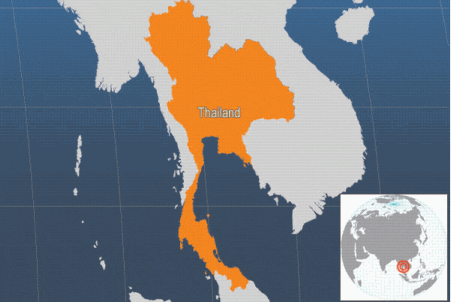
Habitat and biology
Originally known as Pangasius sutchii or Pangasius hypophthalmus, this riverine freshwater species is limited to the Mekong River, the Chaopraya River and possibly the Mekong basins in Cambodia, Lao People's Democratic Republic, Thailand and Viet Nam, together with the Ayeyawady basin of Myanmar, within a range of 19 °N to 8 °N. The species has a variety of common English names including Sutchi catfish, iridescent shark-catfish, and striped catfish. It is called ‘Pa sooai’ and ‘Pa sooai khaeo’ in Laotian, ‘Pla Sawai’ in Thai, ‘Pra’ and ‘Trey pra’ in Khmer and ‘Cá Tra’ in Vietnamese.
Like all Pangasiid species, P. hypophthalmus is a highly migratory riverine fish species that makes long-distance migrations over several hundred kilometres (potamodromous) between upstream refuge and spawning habitats and downstream feeding and nursery habitats. P. hypophthalmus is omnivorous, feeding on algae, higher plants, zooplankton, and insects, while larger specimens also take fruit, crustaceans and fish.
Mature fish can reach a maximum standard total length of 130 cm and up to 44 kg in weight. This species is benthopelagic, typically living within the ranges of pH 6.5-7.5 and 22-26 °C. Females take at least three years to reach sexual maturity in captivity (being then over 3 kg in weight), while males often mature in their second year, probably taking about the same time in the wild. A mature 10 kg female can spawn over one million eggs. Wild broodstock typically spawn twice annually but in cages in Viet Nam have been recorded as spawning a second time 6 to 17 weeks after the first spawning.
The life cycle of P. hypophthalmus is intimately tied to the annual monsoon flood cycle, with spawning taking place in May - June at the start of the monsoon season. In the dry season this and other species congregate and shelter in the deeper refuge areas. The spawning habitat consists of rapids and sandbanks interspersed with deep rocky channels and pools. The eggs are sticky eggs and are deposited onto the exposed root systems of rheophilic tree species like Gimenila asiatica.
Aquaculture introductions have taken place to several other Asian countries including Bangladesh, China, India, Indonesia, Malaysia and Myanmar.
Production
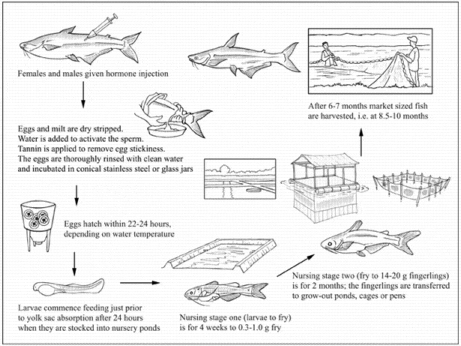
Production systems
In the Mekong delta of Viet Nam the capture of wild Pangasius hypophthalmus seed for aquaculture stocking has been entirely replaced by the stocking of hatchery-produced seed. However, operations in Cambodia, Lao People's Democratic Republic and, to a lesser extent, Thailand still use wild-captured juveniles as seed for cage and pond culture.
Mature broodstock P. hypophthalmus are induced to spawn in hatcheries using HCG or HCG and pituitary gland extract. Female broodstock are given between 2-4 hormone injections while males are injected only once when the female resolving dose is given. Broodstock are spawned in single pairs or in larger numbers and are usually dry stripped. The eggs are incubated in conical shaped jars made either of stainless steel or glass, with up-welling water flow to keep the eggs in suspension. Depending on water temperature, the eggs hatch usually hatch within 22-24 hours. Yolk sac absorption takes a further 24 hours. The larvae are transferred from the hatchery just prior to full yolk sac absorption
Nursing is done in 2 separate stages to reduce stocking density. Earthen nursery ponds, typically 1 000-5 000 m2, are pre-prepared by drying (1-3 days, depending on season), liming (1 t/ha), filling and stocking with Moina (20-30 kg/ha). Water supplied to nursery ponds is filtered through fine meshed cloth to exclude predators. In the first nursing phase larvae are stocked at 400-500/m2 just prior to yolk sac absorption, so that natural feeds are available and the larvae have enough space to avoid cannibalism. Water is only topped up and is not exchanged during the nursery phase unless water quality deterioration is obviously causing stress. Boiled egg yolk and soybean meal mixed into an emulsion is fed 5 -6 times a day for the first 2 weeks. Thereafter commercial pellets are fed.
After 4 weeks, following a 24 hour starvation period the nursery ponds are partially (about 1/3 depth) gravity drained and then pumped dry, and the 0.3-1 g fry are harvested by seine net and transferred and stocked at 150-200/m2 in another pre-prepared pond without Moina. Typical larvae to fry survival rate during the first nursing stage is 40-50 per cent. In the second nursing stage, from fry to 14-20 g fingerlings, survival rates over the 2 month nursing period are typically 60-70 per cent.
In the Mekong delta of Vietnam the majority of fingerlings are transported from nursery facilities to grow-out farms in transport tanks with continuously pumped water that are carried in boats. Fingerling transport is done early in the morning to avoid direct sunlight. Transportation of fingerlings overland is less commonly conducted; this involves using metal drums with car battery powered aeration. Additionally, transportation overland for very short distances can be carried out in metal drums without aeration.
Being a facultative air breather P. hypophthalmus tolerates dissolved oxygen as low as 0.05 to 0.10 mg/litre, highly polluted water (chemical oxygen demand = 25), and can be stocked at densities as high as 120/m2.
The three most common on-growing monoculture systems are earthen ponds, net cages and net pens. The latter two are sited on major river tributaries of the Mekong River delta. Small-scale integrated pond polyculture systems, which were previously common, are being phased out.
Ponds
Earthen ponds (typically ranging from 1 000 to 10 000 m2) are of simple design and are sited adjacent to or near river tributaries. Producers aerate the ponds and exchange water for several hours daily during the culture period by tidal exchange and pumping; this reduces muddy off-flavour and produces whiter flesh. Despite recommendations from government extension agencies to stock 20-40 fish/m2, intensive monoculture ponds are usually stocked at 40-60/m2, with some grow-out farmers stocking even higher. Yields reach 250-300 tonnes/ha/crop, exceptionally reaching 500 tonnes/ha/crop in ponds. Striped catfish reach 1.0-1.5 kg after 6 months or less, depending on the size of fingerlings stocked. Today (2010) few striped catfish monoculture grow-out producers can be described as ‘small-scale’ because the minimum harvest from a single pond is usually 50 tonnes or more.
Net cages
Net cages are sited on major river tributaries of the Mekong River delta and range in size from 50 to 1 600 m3 with larger cages commonly having living quarters above the water. Ongrowing cages are typically stocked at 100-150/m3 and yields are typically 100-120 kg/m3/crop.
Net pens
Stocking densities for pen systems are typically 40-60/m2, producing yields of 300-350 tonnes/ha/crop, although levels as high as 500 tonnes/ha/crop have been are reported.
In the 1990’s, most Vietnamese striped catfish ongrowing producers used farm-made feeds prepared from various ingredients, including trash fish, rice bran, soybean meal, blood meal, broken rice, cottonseed flour, milk, eggs and vegetables (e.g. water spinach and green peas), supplemented with Vitamin C and E premixes. The ingredients are mixed together, cooked and fed in balls or extruded into noodle strands or pellets.
From 2008, with food safety concerns and fluctuating farm-made feed quality, there is now an increasing trend towards the use of commercial pellets. The unit cost of farm-made feeds is cheaper but these feeds have FCRs of 2.8-3.0:1 and cause greater water quality deterioration. The feed conversion ratio of P. hypophthalmus fed commercial pellets is typically 1.7-19:1. Larger-scale producers in Viet Nam only use commercial pellets, while medium-scale grow-out producers typically usually use commercial pellets for the first month and the last month of the ongrowing period and farm-made feeds for the middle four months. This technique reduces the cost of each kilogram of fish produced despite the higher FCRs of farm-made feeds. Depending on rearing intensity feed represents 65-85 per cent of ongrowing costs.
Striped catfish are harvested from ponds by netting, following partial tidal gravity drainage and pumping. Cages are harvested by raising the cage netting by hand. It is normal for an entire pond or cage to be harvested at a single time to meet the large volume requirements of processing plants. Net pens are harvested by seine netting on spring low tides.
The harvested fish are usually transferred to processing plants live in well boats without aeration by river.
The majority of striped catfish is exported in freezer containers by sea as frozen fillets (2.7-3.3 kg of fish is required to produce 1 kg of fillet). Live whole fish are sold in the domestic market, being transported either in well boats without aeration or in tanks on trucks with aeration.
Production costs for household-scale intensive pond-reared P. hypophthalmus are relatively stable but margins are extremely tight. Production costs in early 2009 for commercial-scale striped catfish grow-out producers were approximately VND 15 000/kg (USD 0.83/kg) excluding capital investment costs; this was offset by sale prices of VND 16 000/kg (USD 0.89/kg). At that time household-scale grow-out producers were only being paid VND 14 000-15 000 (USD 0.78 – 0.83/kg) for market sized fish by processing plants but their production costs at approximately VND 13 000 – 14 000 (USD 0.72 – 0.78 kg) excluding capital investment costs were lower . Most grow-out farmers view capital investment costs as a ‘sunk cost’. Profit margins in early 2009 were so tight that striped catfish grow-out farmers in Vietnam were unlikely to recover their capital investment costs fully.
Diseases and control measures
Despite large tonnages being produced at extremely high densities large-scale disease outbreaks and mortality of Pangasius hypophthalmus seldom occur. The following diseases, however, have been recorded.
In some cases antibiotics and other pharmaceuticals have been used in treatment but their inclusion in this table does not imply an FAO recommendation.
| DISEASE | AGENT | TYPE | SYNDROME | MEASURES |
|---|---|---|---|---|
| Bacillary Necrosis of Pangasius (BNP) | Edwardsiella ictaluri | Bacterium | Petechial haemorrhages on eyes and fin bases; white spots in the kidney, spleen and liver; some cellular necrosis | Antibiotics |
| Motile Aeromonad Septicaemia (MAS) | Aeromonas spp. (mainly A. hydrophila, A. sobria and A. caviae) | Bacterium | Haemorrhages on eyes, body and fins; bloody ascites in the peritoneum, leading to swollen belly | Improved water quality and nutrition; antibiotics |
| Jaundice disease | Not confirmed | Not confirmed | Yellowing of the flesh | Improved husbandry and nutrition; antibiotics |
Parasite infections including Ichthyophthirius and Trichodina can occur at the fingerling stage and are usually treated with 15-20 ppt of formalin for 30 minutes with aeration before water exchange. The fluke worm (Clonorchis sinensis) can infect the liver during the grow-out stage. Prevention by thorough pond preparation is essential because treatment with drugs takes time and has a low efficacy.
Suppliers of pathology expertise
The following institutions can provide expertise on this topic:
- Sub-offices of the Department of Animal Health, of the Department of Agriculture and Rural Development in Viet Nam.
- Research Institute for Aquaculture #2, Ho Chi Minh City, Viet Nam.
- Aquaculture Faculty, Can Tho University, Viet Nam.
- Institute of Aquaculture, University of Stirling, United Kingdom.
Statistics
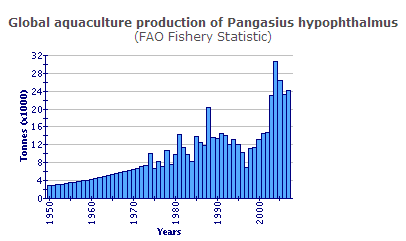
Viet Nam is by far the world’s largest producer of Pangasius hypophthalmus, producing >1.1 million tonnes in 2008 (POSMA, 2009). Other producers are Thailand, Cambodia, Lao People's Democratic Republic, Myanmar, Bangladesh and China.
Market and trade
Viet Nam exports P. hypophthalmus to over 80 countries, including several in Europe (especially Poland and Spain), Asian countries, Mexico, Australia, the US, and the Middle East. New markets such as Russia are emerging. The European Union remains the most significant market (35 per cent by volume, 40 per cent by value).
Viet Nam has the capacity to process 3 500 tonnes of aquatic product daily and the capacity is increasing. There are presently 405 industrial-scale processing plants in Viet Nam, of which 301 are certified for export to Europe and 30 are certified to export to the Russian Federation; 16 per cent are currently ISO certified.
Following low prices at the end of 2008 many Vietnamese farmers failed to stock their ponds in 2009, thus raising market price. The 2009 indicative price of 170 g skinless IQF striped catfish fillets imported into Europe from Viet Nam was USD 2.65/kg.
The farming of Pangasius hypophthalmus has seen it emerge as a commercial freshwater species that is now a significant component of global whitefish supplies. While trade in frozen products generally stagnated in 2007 and 2008, P. hypophthalmus was the exception, with trade increasing 311 per cent, traded primarily as frozen IQF fillets. This species is now a highly competitive, high value white fish product on many markets.
Status and trends
It is anticipated that aquaculture production of Pangasius hypophthalmus will further increase in the medium term. Prices will initially remain stable, but may drop later if China solves its striped catfish production problems and increases output.
However, the farming of this species is a very high risk activity for household-scale production units because profit margins are extremely tight. It is likely in the medium- to long-term that household-scale grow-out producers will go out of business as the industry consolidates. Associated with increasingly strict market requirements for tracking, tracing and product certification, striped catfish farming will probably move toward large-scale vertically integrated operations.
Main issues
Further market research is required (and effective dissemination to producers) on price trends and comparative advantage in domestic and international markets. Additional research is also needed on:
- Marketing and distribution infrastructure, and optimal location of cold storage facilities.
- Production strategies to exploit seasonal price variation.
- Improving the quality and reducing the costs of commercial pelleted feeds in Viet Nam.
Profit margins on Pangasius hypophthalmus grow-out systems are tightening. This will further increase pressure to cut costs and increase efficiency. Smaller less efficient farms are likely to go out of business and there will be consolidation within the industry, with a greater proportion of larger, more efficient vertically integrated striped catfish production units.
There will be increasing pressure from retailers and buyers for P. hypophthalmus produced in environmentally sustainable production systems and in a socially equitable manner. The former will require greater investment and research on improving ongrowing farm design, particularly concerning water intake and treatment, storage, and water treatment and discharge systems.
Responsible aquaculture practices
Discharge of high nutrient loads, with high BOD and COD levels, from intensive pond monoculture of P. hypophthalmus is a major environmental concern that is causing localized pollution. It is anticipated that western retailers and consumers will increasingly only buy fish from production systems that are environmentally friendly.
The following key factors have been recognized as important for promoting responsible striped catfish aquaculture in Viet Nam and enhancing its market share:
- Promotion of and implementation of Pangasius hypophthalmus GAP, BMP and COC nationwide in Viet Nam.
- Effective implementation to prevent transfer of broodstock striped catfish between river catchments to prevent negative impacts on genetically isolated populations.
- Establishment of cost effective product traceability systems throughout the production chain and cost effective group marketing initiatives.
- Development of cost-effective group environmental management and bio-security measures.
- Sharing and dissemination of market price information on input costs and end product.
June 2010



